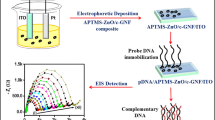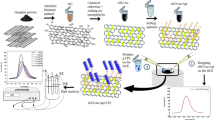Abstract
We describe a Salmonella biosensor that was obtained by electrochemical immobilization of a nanocomposite consisting of reduced graphene oxide (rGO) and carboxy-modified multi-walled carbon nanotubes (MWCNTs) directly on the surface of a glassy carbon electrode (GCE). An amino-modified aptamer specific for Salmonella was covalently bound to the rGO-MWCNT composite via amide bonds. The morphology of the rGO-MWCNT nanocomposite was characterized by transmission electron microscopy and scanning electron microscopy. Cyclic voltammetry and electrochemical impedance spectroscopy were used to monitor all steps during assembly. When exposed to samples containing Salmonella, the anti-Salmonella aptamer on the electrode captures its target. Hence, electron transfer is blocked, and this results in a large increase in impedance. Salmonella can be quantified by this aptasensor, typically operated at a working voltage of 0.2 V (vs. Ag/AgCl), in the range from 75 to 7.5 × 105 cfu⋅mL−1 and detection limit of 25 cfu⋅mL−1 (at an S/N of 3). The method is perceived to have a wide scope in that other bacteria may be detected by analogy to this approach and with very low limits of detection by applying respective analyte-specific aptamers.

The schematic view of the GCE surface modification and the detection of Salmonella





Similar content being viewed by others
References
Daum LT, Barnes WJ, McAvin JC, Neidert MS, Cooper LA, Huff WB, Gaul L, Riggins WS, Morris S, Salmen A, Lohman KL (2002) Real-Time PCR detection of salmonella in suspect foods from a gastroenteritis outbreak in Kerr County, Texas. J Clin Microbiol 40(8):3050–3052
Bakthavathsalam P, Rajendran VK, Saran U, Chatterjee S, Jaffar Ali BM (2013) Immunomagnetic nanoparticle based quantitative PCR for rapid detection of Salmonella. Microchim Acta 180(13–14):1241–1248
Oh BK, Lee W, Kim YK, Lee WH, Choi JW (2004) Surface plasmon resonance immunosensor using self-assembled protein G for the detection of Salmonella paratyphi. J Biotechnol 111(1):1–8
Lee KM, Runyon M, Herrman TJ, Phillips R, Hsieh J (2015) Review of Salmonella detection and identification methods: aspects of rapid emergency response and food safety. Food Control 47:264–276
Ohtsuka K, Yanagawa K, Takatori K, Hara-Kudo Y (2005) Detection of Salmonella enterica in naturally contaminated liquid eggs by loop-mediated isothermal amplification, and characterization of Salmonella isolates. Appl Environ Microbiol 71(11):6730–6735
Roda A, Mirasoli M, Roda B, Bonvicini F, Colliva C, Reschiglian P (2012) Recent developments in rapid multiplexed bioanalytical methods for foodborne pathogenic bacteria detection. Microchim Acta 178(1–2):7–28
Jain S, Chattopadhyay S, Jackeray R, Abid CK, Kohli GS, Singh H (2012) Highly sensitive detection of Salmonella typhi using surface aminated polycarbonate membrane enhanced-ELISA. Biosens Bioelectron 31(1):37–43
Cheung PY, Kam KM (2012) Salmonella in food surveillance: PCR, immunoassays, and other rapid detection and quantification methods. Food Res Int 45(2):802–808
González-Escalona N, Brown EW, Zhang G (2012) Development and evaluation of a multiplex real-time PCR (qPCR) assay targeting ttrRSBCA locus and invA gene for accurate detection of Salmonella spp. in fresh produce and eggs. Food Res Int 48(1):202–208
Malorny B, Paccassoni E, Fach P, Bunge C, Martin A, Helmuth R (2004) Diagnostic real-time PCR for detection of Salmonella in food. Appl Environ Microbiol 70(12):7046–7052
Wang Z, Xu H, Wu J, Ye J, Yang Z (2011) Sensitive detection of Salmonella with fluorescent bioconjugated nanoparticles probe. Food Chem 125(2):779–784
Xu S (2012) Electromechanical biosensors for pathogen detection. Microchim Acta 178(3–4):245–260
Ellington AD, Szostak JW, Green R (1990) In vitro genetic analysis of the Tetrahymena self-splicing intron. Nature 346:818–822
Tuerk C, Gold L (1990) Systematic evolution of ligands by exponential enrichment: RNA ligands to bacteriophage T4 DNA polymerase. Science 249:505–510
Fang Z, Wu W, Lu X, Zeng L (2014) Lateral flow biosensor for DNA extraction-free detection of Salmonella based on aptamer mediated strand displacement amplification. Biosens Bioelectron 56:192–197
Florea A, Taleat Z, Cristea C, Mazloum-Ardakani M, Săndulescu R (2013) Label free MUC1 aptasensors based on electrodeposition of gold nanoparticles on screen printed electrodes. Electrochem Commun 33:127–130
Wu J, Chu H, Mei Z, Deng Y, Xue F, Zheng L, Chen W (2012) Ultrasensitive one-step rapid detection of ochratoxin A by the folding-based electrochemical aptasensor. Anal Chim Acta 753:27–31
Zhang XY, Zhou LY, Luo HQ, Li NB (2013) A sensitive and label-free impedimetric biosensor based on an adjunct probe. Anal Chim Acta 776:11–16
Peng K, Zhao H, Wu X, Yuan Y, Yuan R (2012) Ultrasensitive aptasensor based on graphene-3,4,9,10-perylenetetracarboxylic dianhydride as platform and functionalized hollow PtCo nanochains as enhancers. Sens Actuators B 169:88–95
Sun W, Wang X, Lu Y, Gong S, Qi X, Lei B, Sun Z, Li G (2015) Electrochemical deoxyribonucleic acid biosensor based on electrodeposited graphene and nickel oxide nanoparticle modified electrode for the detection of salmonella enteritidis gene sequence. Mater Sci Eng C Mater Biol Appl 49:34–39
Ananthi A, Kumar SS, Phani KL (2015) Facile one-step direct electrodeposition of bismuth nanowires on glassy carbon electrode for selective determination of folic acid. Electrochim Acta 151:584–590
Wang B, Ji X, Zhao H, Wang N, Li X, Ni R, Liu Y (2014) An amperometric beta-glucan biosensor based on the immobilization of bi-enzyme on Prussian blue-chitosan and gold nanoparticles-chitosan nanocomposite films. Biosens Bioelectron 55:113–119
Liu J, Wang X, Wang T, Li D, Xi F, Wang J, Wang E (2014) Functionalization of monolithic and porous three-dimensional graphene by one-step chitosan electrodeposition for enzymatic biosensor. ACS Appl Mater Interfaces 6(22):19997–20002
Hummers W, Offeman R (1958) Preparation of graphitic oxide. J Am Chem Soc 80:1339
Joshi R, Janagama H, Dwivedi HP, Senthil Kumar TM, Jaykus LA, Schefers J, Sreevatsan S (2009) Selection, characterization, and application of DNA aptamers for the capture and detection of Salmonella enterica serovars. Mol Cell Probes 23(1):20–28
Pérez-López B, Merkoçi A (2012) Carbon nanotubes and graphene in analytical sciences. Microchim Acta 179(1–2):1–16
Li J, Feng H, Feng Y, Liu J, Liu Y, Jiang J, Qian D (2014) A glassy carbon electrode modified with β-cyclodextin, multiwalled carbon nanotubes and graphene oxide for sensitive determination of 1,3-dinitrobenzene. Microchim Acta 181(11–12):1369–1377
Yang L (2008) Electrical impedance spectroscopy for detection of bacterial cells in suspensions using interdigitated microelectrodes. Talanta 74(5):1621–1629
Shabani A, Marquette CA, Mandeville R, Lawrence MF (2013) Magnetically-assisted impedimetric detection of bacteria using phage-modified carbon microarrays. Talanta 116:1047–1053
Chen M, Lin Y, Gu C, Wang J (2013) Arsenic sorption and speciation with branch-polyethyleneimine modified carbon nanotubes with detection by atomic fluorescence spectrometry. Talanta 104:53–57
Yuan JL, Tao Z, Yu Y, Ma XY, Xia Y, Wang L, Wang ZP (2014) A visual detection method for Salmonella Typhimurium based on aptamer recognition and nanogold labeling. Food Control 37:188–192
Wu W, Li J, Pan D, Li J, Song S, Rong M, Li Z, Gao J, Lu J (2014) Gold nanoparticle-based enzyme-linked antibody-aptamer sandwich assay for detection of Salmonella Typhimurium. ACS Appl Mater Interfaces 6(19):16974–16981
Duan YF, Ning Y, Song Y, Deng L (2014) Fluorescent aptasensor for the determination of Salmonella typhimurium based on a graphene oxide platform. Microchimica Acta 181(5–6):647–653
Ozalp VC, Bayramoglu G, Kavruk M, Keskin BB, Oktem HA, Arica MY (2014) Pathogen detection by core-shell type aptamer-magnetic preconcentration coupled to real-time PCR. Anal Biochem 447:119–125
Wu W, Li M, Wang Y (2012) Aptasensors for rapid detection of Escherichia coli O157:H7 and Salmonella typhimurium. Nanoscale Res Lett 7:658–665
Acknowledgments
This work was partly supported by the National S&T Support Program of China (2012BAK08B01, 2012BAD28B02), NSFC (21375049), the China Agriculture Research System Poultry-related Science and Technology Innovation Team of Peking (CARS-PSTP).
Author information
Authors and Affiliations
Corresponding authors
Electronic supplementary material
Below is the link to the electronic supplementary material.
ESM 1
(DOC 732 kb)
Rights and permissions
About this article
Cite this article
Jia, F., Duan, N., Wu, S. et al. Impedimetric Salmonella aptasensor using a glassy carbon electrode modified with an electrodeposited composite consisting of reduced graphene oxide and carbon nanotubes. Microchim Acta 183, 337–344 (2016). https://doi.org/10.1007/s00604-015-1649-7
Received:
Accepted:
Published:
Issue Date:
DOI: https://doi.org/10.1007/s00604-015-1649-7




